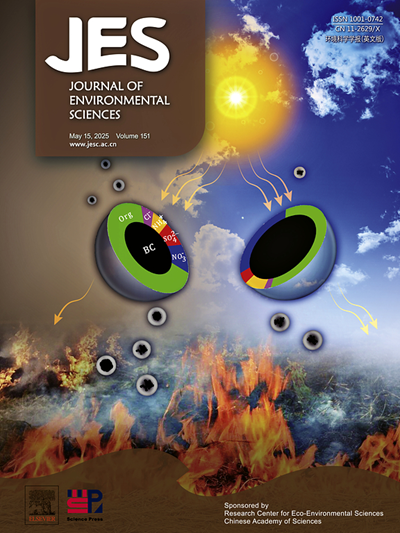Distribution of antibiotic resistance genes on chromosomes, plasmids and phages in aerobic biofilm microbiota under antibiotic pressure
IF 5.9
2区 环境科学与生态学
Q1 ENVIRONMENTAL SCIENCES
引用次数: 0
Abstract
The objective of this study is to quantitatively reveal the main genetic carrier of antibiotic resistance genes (ARGs) for blocking their environmental dissemination. The distribution of ARGs in chromosomes, plasmids, and phages for understanding their respective contributions to the development of antimicrobial resistance in aerobic biofilm consortium under increasing stresses of oxytetracycline, streptomycin, and tigecycline were revealed based on metagenomics analysis. Results showed that the plasmids harbored 49.2 %-83.9 % of resistomes, which was higher (p < 0.001) than chromosomes (2.0 %-35.6 %), and no ARGs were detected in phage contigs under the strict alignment standard of over 80 % identity used in this study. Plasmids and chromosomes tended to encode different types of ARGs, whose abundances all increased with the hike of antibiotic concentrations, and the variety of ARGs encoded by plasmids (14 types and 64 subtypes) was higher than that (11 types and 27 subtypes) of chromosomes. The dosing of the three antibiotics facilitated the transposition and recombination of ARGs on plasmids, mediated by transposable and integrable transfer elements, which increased the co-occurrence of associated and unassociated ARGs. The results quantitatively proved that plasmids dominate the proliferation of ARGs in aerobic biofilm driven by antibiotic selection, which should be a key target for blocking ARG dissemination.

抗生素压力下好氧生物膜微生物群中抗生素抗性基因在染色体、质粒和噬菌体上的分布
本研究的目的是定量揭示抗生素耐药基因(ARGs)的主要遗传载体,以阻断其环境传播。基于宏基因组学分析,揭示了ARGs在染色体、质粒和噬菌体中的分布,以了解它们在土霉素、链霉素和替加环素胁迫下好氧生物膜联系体耐药发展中的作用。结果表明,该质粒携带抗性体的比例为49.2% ~ 83.9%,比其他质粒高(p <;0.001)高于染色体(2.0% - 35.6%),在本研究采用的80%以上的严格比对标准下,噬菌体contigs中未检测到ARGs。质粒和染色体倾向于编码不同类型的ARGs,其丰度均随抗生素浓度的增加而增加,且质粒编码的ARGs种类(14型64亚型)高于染色体编码的ARGs种类(11型27亚型)。三种抗生素的剂量促进了ARGs在质粒上的转座和重组,由转座和可整合的转移元件介导,从而增加了相关和非相关ARGs的共发生。结果定量证明,在抗生素选择的驱动下,质粒主导了ARG在好氧生物膜中的增殖,这应该是阻断ARG传播的关键靶点。
本文章由计算机程序翻译,如有差异,请以英文原文为准。
求助全文
约1分钟内获得全文
求助全文
来源期刊

Journal of Environmental Sciences-china
环境科学-环境科学
CiteScore
13.70
自引率
0.00%
发文量
6354
审稿时长
2.6 months
期刊介绍:
The Journal of Environmental Sciences is an international journal started in 1989. The journal is devoted to publish original, peer-reviewed research papers on main aspects of environmental sciences, such as environmental chemistry, environmental biology, ecology, geosciences and environmental physics. Appropriate subjects include basic and applied research on atmospheric, terrestrial and aquatic environments, pollution control and abatement technology, conservation of natural resources, environmental health and toxicology. Announcements of international environmental science meetings and other recent information are also included.
 求助内容:
求助内容: 应助结果提醒方式:
应助结果提醒方式:


